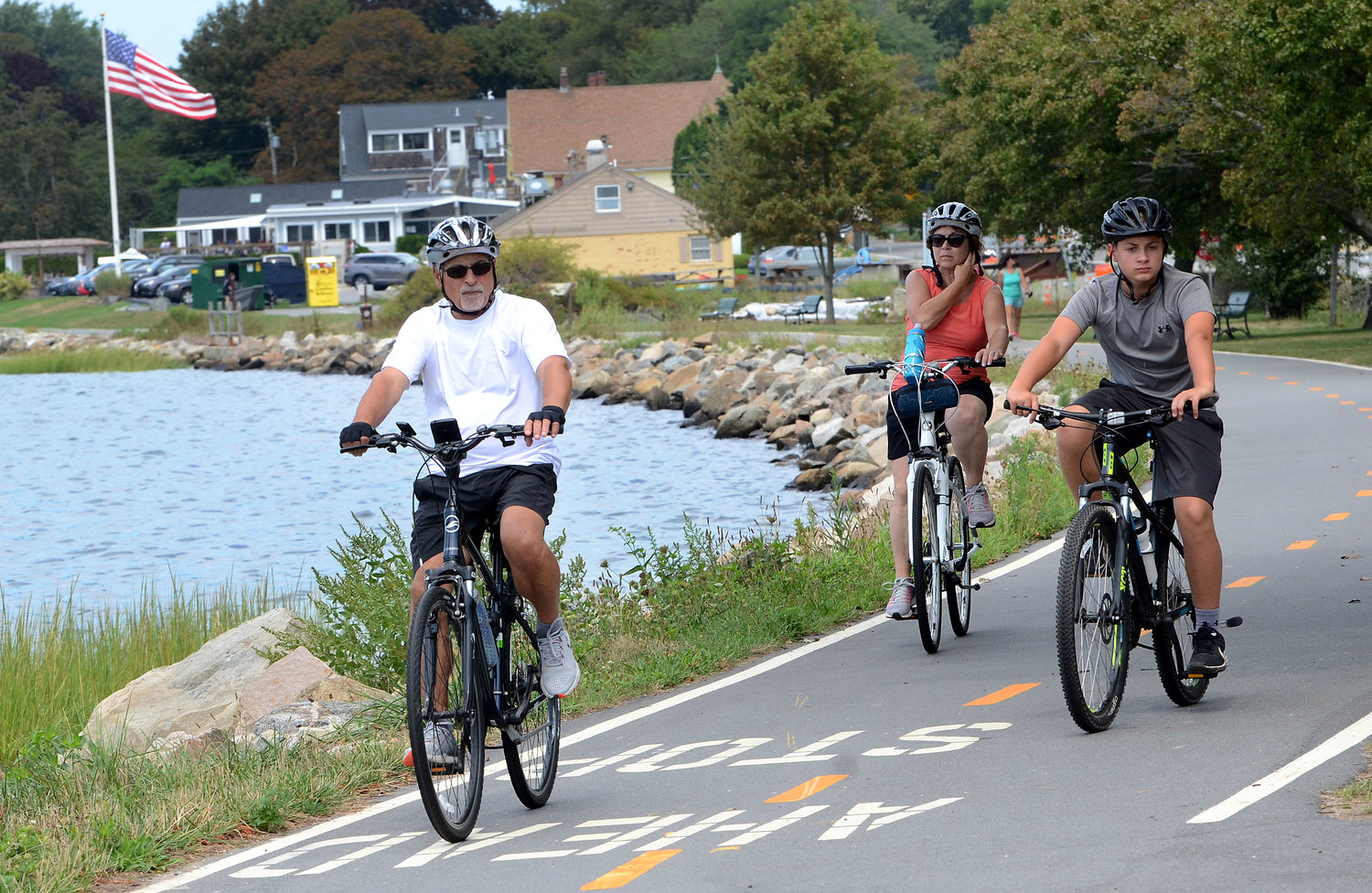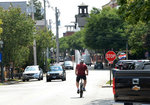Engineers outline four routes to connect campus and downtown Bristol
Small group of Bristol residents make it clear which routes they don't like
The Town of Bristol wants to connect the southern end of the East Bay Bike Path to the southern end of Bristol. The big questions are how, and how much?
The town has so far formed a task force to …
This item is available in full to subscribers.
Please log in to continue |
Register to post eventsIf you'd like to post an event to our calendar, you can create a free account by clicking here. Note that free accounts do not have access to our subscriber-only content. |
Day pass subscribers
Are you a day pass subscriber who needs to log in? Click here to continue.
Engineers outline four routes to connect campus and downtown Bristol
Small group of Bristol residents make it clear which routes they don't like
The Town of Bristol wants to connect the southern end of the East Bay Bike Path to the southern end of Bristol. The big questions are how, and how much?
The town has so far formed a task force to explore the possibilities, hired engineers and a design team to conceive of different routes, and worked with Roger Williams University faculty and students to research the idea. They’ve developed four possible pathways to bring bikers from the Mt. Hope Bridge and the university campus into or near the downtown district. Now they want to know what residents and bikers think.
During a Town of Bristol Department of Community Development public forum Tuesday night, it was clear what one neighborhood thinks — they don’t want the path running along Griswold Avenue. Numerous Griswold residents spoke during the meeting, held on the video conference platform Zoom, and they all raised objections to bringing the bikes past their relatively rural and scenic section of town.
Leeds Mitchell said, “You need to consider what it does to the citizens first and the bikes second. What is going to happen to the town? Is the value of my house going to go down? Am I going to pull out of my driveway and worry about getting hit by a bike?”
Neighbor Paulette Carr, who also wrote a long letter of objections to the town, said bringing bikers through the area, particularly if it means creating a path through undeveloped wetlands and woodlands, could “change the entire fiber of the Griswold Avenue neighborhood.” Two of the potential routes would include a section of path that turns north off Griswold through a wet, wooded area, possibly including small wooden bridges and clearing of land.
“We are not against the bike path, but we are against a bike path that is costly or is in an area that disrupts neighborhoods or an environmentally sensitive area,” Ms. Carr said.
Two other Griswold residents, Larry Wilson and Ed Miller, also questioned why the town would send bikers along Griswold Avenue. Mr. Wilson said bikers will naturally take the shortest route, which happens to run from the campus along Ferry Road. He also felt sending bikers through the downtown district would generate the greatest economic benefit for the town.
Mr. Wilson similarly suggested that a Ferry Road route makes the most sense, with the lowest cost and greatest potential economic boost.
Four possible routes
For the first half of Tuesday’s meeting, the design team outlined the four possible routes they’ve generated thus far. Arnold Robinson, of the firm Fuss & O’Neill, led much of the meeting, along with Karen Fitzgerald of Toole Design.
Mr. Robinson told the audience that there are no favorite options and no “right” answers at this point. “We’re really at the beginning of this, and no one has the right answer, but everyone may have a piece of the answer,” he said.
All four routes begin at the southern end of Bristol, presumably at the Roger Williams campus. Three of the routes run north along Metacom Avenue and turn left onto Griswold Avenue. From there, the three routes follow different paths, with one connecting to Ferry Road and Wood Street and then continuing downtown. The other two Griswold routes cut through the woodlands and ultimately reach Wood Street through different paths.
The estimated costs to construct those three routes range from $2 million to $3.5 million.
The fourth option, and the one that emerged as the favorite from the group of citizens in Tuesday’s meeting, is the only one that does not travel along Griswold Avenue. This route runs entirely along Ferry Road — not Metacom Avenue — before connecting to High Street right in front of the Lobster Pot restaurant, then working its way down to Thames Street.
Noteworthy in this route is the vision for Thames Street, which would become a different type of street than it is currently, with bikes, vehicles and pedestrians allowed equal access to the roadway. Ms. Fitzgerald talked about how bikes and cars blend seamlessly, and safely, in cities around the world that use this type of system.
The Ferry Road option
Engineers believe the Ferry Road route can be built for about $1.5 million, making the least expensive of the four options so far considered. Bristol resident Mary Kae Wright was one of those supporting this route, adding that in all her years of biking in Bristol, she has always avoided Metacom Avenue for safety reasons.
Ms. Wright asked what the impact would be on Ferry Road itself, as did others. They wanted to know what might happen to the sidewalks, trees and ambience in that area of town.
Mr. Robinson said the west side of Ferry seems to be the best option for a bike lane, but they need to do much more research on the tree canopy, the sidewalks and the width of the right of way between the street and the private properties along the route.
A couple of residents spoke in favor of any bike path; they’re just supportive of the concept. Mike Dieterich, an avid and longtime biker, said he bikes along Griswold all the time — “it’s a beautiful road,” he told the residents — and he suggested that their objections to a bike path in their neighborhood were the same objections brought about decades ago when the state was first considering the East Bay Bike Path. Now, he said, real estate listings often tout their proximity to the bike path as a selling point.
Mr. Dieterich went further and also suggested to the folks from Roger Williams that they consider how to open their campus to public biking, for both scenic and convenience purposes. “It’s a beautiful campus, and this is a partnership between the university and the town,” he said.
Roger Williams University President Ioannis Miaoulis did not attend Tuesday’s forum, but he submitted a statement of support for the project on Wednesday morning: “Throughout the 50 years of our Bristol campus, Roger Williams University and the town have forged a strong relationship, but a potential bike path extension to our campus will represent a physical symbol of our connection and allow us to deepen our ties with Bristol. I’m sure our students can’t wait for this to become a reality so they can have greater access to visiting the town’s wonderful restaurants and businesses.”
Seeking public feedback
The bike path connection study is funded by a grant from the 2018 Green Economy Bond of Rhode Island Department of Environmental Management. The program supports communities improving facilities for cycling and recreation.
Roger Williams University has been involved in the planning process, with both students and faculty providing input and research. Recently retired professor Chris Menton, a Bristol resident and passionate advocate for biking and bike safety, was a motivating force behind the idea in the first place.
However, this is not a university project; it is a Town of Bristol project, said Director of Community Development Diane Williamson. She also wants everyone to know that all feedback is welcomed. “We can’t do this in a vacuum. We need your input,” she said.
The Bristol Town Council is expected to talk about the bike path connector at its next couple of meetings, and there will be another public forum in September. Residents are also encouraged to learn more about the project, view the possible routes, and post comments on a website built specifically for this project:
https://sites.google.com/view/bristol-bicycle-connector/home.











